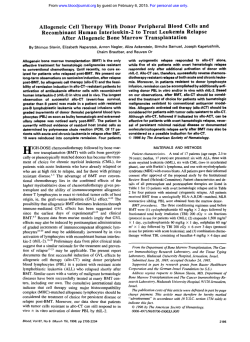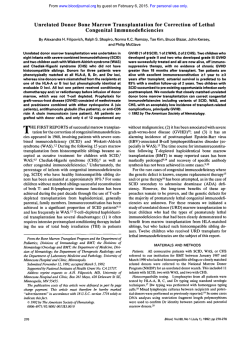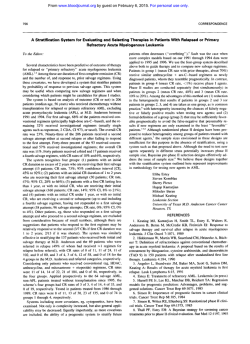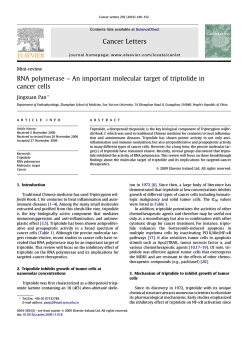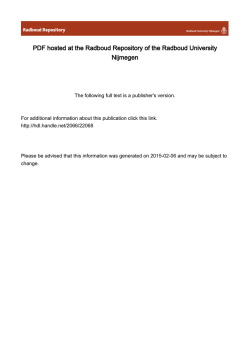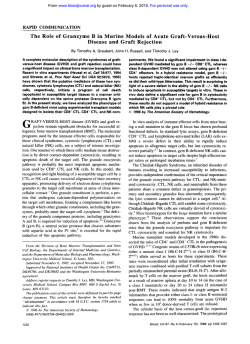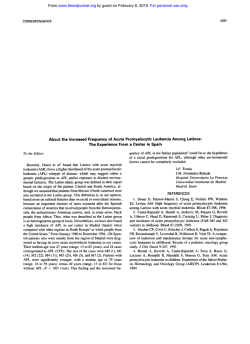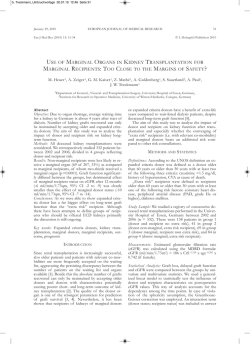
1 - Radboud Repository
PDF hosted at the Radboud Repository of the Radboud University
Nijmegen
The following full text is a publisher's version.
For additional information about this publication click this link.
http://hdl.handle.net/2066/22128
Please be advised that this information was generated on 2015-02-06 and may be subject to
change.
Graft-Versus-Leukemia Effect of Donor Lymphocyte Transfusions in
Marrow Grafted Patients
By Hans-Jochem Kolb, Anton Schattenberg, John M. Goldman, Bernd Hertenstein, Niels Jacobsen, William Arcese,
Per Ljungman, Augustin Ferrant, Leo Verdonck, Dietger Niederwieser, Frits van Rhee, Johann Mittermueller,
Theo de Witte, Ernst Holler, and Hassan Ansari for the European Group for Blood and Marrow Transplantation
Working Party Chronic Leukemia
The immune reactivity of allogeneic lymphocytes plays a
major role in the control of leukemia after bone marrow
transplantation. In patients with recurrent leukemia after
marrow transplantation, chimerism and tolerance provide
ideal conditions for adoptive immunotherapy with donor
lymphocytes. We studied the effect of donor lymphocyte
transfusions on acute and chronic leukemia in relapse after
bone marrow transplantation. One hundred thirty-five pa
tients with chronic myeloid leukemia (CML) (N = 84), acute
myeloid leukemia (AML) (N = 23), acute lymphoblastic leuke
mia (ALL) (N = 22), myelodysplastic syndrome (MDS) (INI =
5), and polycythemia vera with osteomyelofibrosis (PCV) (N
= 1) were treated with transfusions of donor lymphocytes.
Patients were monitored for response of leukemia, including
in CML, the use of the polymerase chain reaction for bcr/abl
mRNA transcripts and for the occurrence of graft-versushost disease (GVHD) and myelosuppression. Complete re
missions were induced by donor lymphocyte transfusions
in 54 patients with CML (73%) and in the patient with PCV;
complete remissions were also induced in five patients (29%)
with AML and a patient with MDS. In contrast, ALL did not
respond to adoptive immunotherapy with donor lympho
cyte transfusions. Remissions were durable in patients
treated for CML in chronic phase (probability of remission:
87% at 3 years). Lymphocyte transfusions were also given
to 18 patients with ALL, AML, MDS, and transformed phase
CML who were in remission after chemotherapy. These re
missions were not durable. Fifty-two patients (41%) devel
oped GVHD of grade 2 or more, and 41 patients (34%)
showed signs of myelosuppression. Seventeen patients died
without leukemia, 14 patients with GVHD and/or myelosup
pression. Donor lymphocyte transfusions exert strong ef
fects against myeloid forms of leukemia and induce durable
remissions in CML.
© 1995 by The American Society of Hematology.
HE ROLE OF ALLOGENEIC lymphocytes in the eradi
cation of leukemia is well established. In mice, trans
plantation of allogeneic bone marrow eliminated leukemia,
and transplantation of marrow from syngeneic donors failed.1
Allogeneic marrow transplantation as a form of adoptive
immunotherapy of leukemia was limited by the inevitable
occurrence of graft-versus-host disease (GVI-ID).2
with GVHD had fewer relapses than patients without GVHD,
but only patients with mild degrees of GVHD had a survival
advantage/ T lymphocytes are most probably responsible
for GVHD and the graft-versus-leukemia (GVL) effect;
depletion of T lymphocytes decreased the incidence and se
verity of GVHD, but increased the risk of relapse.4,5 How
ever, a beneficial effect of adding T lymphocytes early after
transplantation on high-risk leukemia could not be shown.
Transfusion of donor lymphocytes early after transplantation
increased the incidence and severity of acute GVHD without
improving the control of leukemia.*’ A possible solution of
the dilemma between the risk of GVHD and the benelil of
a GVL effect was sought in delaying the transfusion of donor
lymphocytes to a time when GVH tolerance was established.
In canine chimeras, the delay of the transfusion for 2 months
or longer after transplantation prevented acute GVHD without
abrogating the beneficial effect on chimerism and the transfer
of immunity.7 Indeed, the first patients treated with transfusion
of donor lymphocytes showed only mild or no GVHD.K
In the meantime, we" and others4' 15 have shown that remis
sions can be induced in patients with chronic myelogenous
leukemia (CML) in relapse after marrow transplantation by
the transfusion of lymphocytes from the marrow donor with
out chemo or radiotherapy. Occasional patients with acute
myeloid leukemia (AML) have benefited from donor lym
phocyte transfusions,16 but in general, the response of differ
ent types of leukemia to the GVL effects of donor lympho
cyte transfusions is not known. Here we review the results
reported by 27 transplant centers in the European Group for
Blood and Marrow Transplantation (EBMT) and evaluate
the risks and benefits of donor lymphocyte transfusions in
patients with recurrent CML in various stages, AML, acute
lymphoblastic leukemia (ALL), myelodysplastic syndrome
(MDS), and polycythemia vera (PCV).
Blood, Vol 86, No 5 (September 1), 1995: pp 2041-2050
From the Medizinische Klinik Hi, Klinikum Grosshadern, Universitaet M uenchm, und GSF— Forschungszentrum fiter Umwelt
mul Gesundheit; Munich, Germany; the Division o f Hematology, the
Department o f Internal Medicine, University Hospital Nijmegen,
Nijmegen, Netherlands; LRF Leukaemia Unit, the Department o f
Haematology, Royal Postgraduate Medical School, Hammersmith
Hospital, London, UK; Abteilung Innere Medizin HI, Medizinische
Universitätsklinik und Poliklinik, Universitaet Ulm, Ulm, Germany;
Unit fo r Hone Marrow Transplantation, Rijgsliospitalct, Copenha
gen, Denmark; Uniki di Trapia/ito di Midollo Osseo Allogenico,
Sezione Ematologia, Universitü degli Studi "La Sapieuza", Rome,
Italy; Karolinska Institute, the Department o f Medicine, linddinge ,
Sweden; Service d ’Henutlologle, Cliniques Universitaires Saint-Luc,
Université Catludic/ue de Louvain, Bruxelles, Belgium; the Depart
ment o f Haematology, University o f Utrecht, Utrecht, Netherlands;
Aht. Imnumbiologie, Medizinische Klinik, Universitaet Innsbruck,
Innsbruck, Austria; Biometrisches Zentrum, Muenchen, Germany.
Submitted February 15, 1995; accepted April 27, ¡995,
Supported by Grant No. DFG-Ko-NI-l383-1 from the Deutsche
Forschungsgemeinschaft.
Address reprint requests to Hans-Jochem Kolb, MD, Med.Klinik
Ul, Klinikum Grosshadern, University o f Munich, Marchionimstr.
15, ft1377 Muenchen, Germany.
The publication costs o f this article were defrayed in part by page
charge payment. This article must therefore he hereby marked
‘'advertisement” in accordance with 18 U.S.C. section 1734 solely to
indicate this fact,
ft') 1995 by The American Society o f Hematology.
0006-4971/95AH605-0021$3.00/0
2041
KOLB ET AL
2042
M A T E R IA L S A N D M E T H O D S
Data collection. Centers for bone marrow transplantation partic
ipating in tiie European Group for Blood and Marrow Transplanta
tion (EBMT) were asked to report their experience with donor lym
phocyte transfusions for the treatment of recurrent leukemia after
marrow transplantation. Between May 1992 and May 1994. we re
ceived reports on 140 treatment episodes in 135 patients from 27
centers. Attempts were made to prevent selective reporting of favor
able cases. Centers were asked to report all sequentially treated
patients, and the results were discussed with each center.
The reports included data on age and sex of the patients and their
donors, diagnosis and stage of the disease at the time of transplanta
tion, histocompatibility and relationship of the donor, date of trans
plant, conditioning regimen, method of prophylaxis of GVHD, sever
ity of acute and chronic GVHD, as well as other major complications
after transplantation, time of relapse, leukocyte count and the per
centage of blasts, cytogenetic data on the percentage of Philadelphiapositive metaphases and other karyotype abnormalities, presence of
GVHD and evidence of chimerism at the time of leukemic relapse,
and in case of CML, the type of relapse, ie, cytogenetic, hematologic,
or in transformation. Treatment related information included details
of chemotherapy, the dates of administration and response, details
of treatment with interferon-« and clinical, as well as cytogenetic
response, date and number of days with lymphocyte transfusions,
number of mononuclear cells transfused, and the response to the
transfusion. The outcome o f the treatment was assessed by: (I)
severity of GVHD, involvement of skin, liver and gut; (2) leukope
nia, thrombocytopenia, and reticulocytopema secondary to the lym
phocyte transfusion and unrelated to chemotherapy; (3) response of
the leukemia including karyotype analyses and reverse transcriptase
polymerase chain reactions of bcr/abl c-DNA. Survival, causes of
morbidity and death, and recurrence of leukemia after lymphocyte
transfusions were also evaluated.
Patients. The patients’ characteristics are summarized in Table
I. Eighty-four patients were treated for recurrent CML. I patient for
PCV, 23 patients for AML, 5 patients for MDS, and 22 patients for
ALL,. The median age of both the patients and the donors was 35
years. One hundred seventeen patients had an HLA-identical sibling
donor, 11 patients had an unrelated donor, in 6 patienLs the donor
was mismatched for one HLA-antigen, and 1 patient had a monozy
gotic twin donor.
Definitions. Relapse of leukemia was delined as the recurrence
of signs and symptoms of leukemia including cytogenetic evidence.
In CML., cytogenetic relapse was defined as the recurrence of meta
phases with the Philadelphia-ehromosome without hematologic or
clinical features of CML. Hematologic relapse is the recurrence
of CML with the characteristics of chronic phase disease, whereas
transformed relapse is the recurrence with the characteristics of ac
celerated or blastic phase. Blastie phase is defined as an increase of
blasts in marrow to 30% or more and/or in blood to 20% or more.
Accelerated phase is delined as an increase of blasts, eosinophils,
and basophils unresponsive to conventional chemotherapy not ful
filling the criteria of blast phase. In PCV, relapse was delined as
recurrence of host hematopoiesis with leukocytosis and thromboComplete remission was delined as the absence of signs or symp
toms of leukemia and the return of normal blood counts and bone
marrow cel hilarity in the absence of antileukemic therapy. In CML,
a negative reverse transcriptase polymerase chain reaction (RT-PCR)
for bcrlabl transcripts17 in marrow or blood and/or the absence of
metaphases with the Philadelphia chromosome was necessary for
confirmation. Initially only cytogenetic results were available," until
more recent RT-PCR was established as a standard method. Re
sponse was evaluable in patients who survived at least 30 days
after lymphocyte transfusions because the earliest responses were
observed 4 weeks after treatment.
Leukocytopenia and thrombocytopenia unrelated to chemotherapy
did not contradict the definition of complete remission based on RTPCR and cytogenetic results, because they may occur in the course
of a GVL reaction.
Cytopenia caused by marrow aplasia was observed in some pa
tients I or 2 months after lymphocyte transfusion. Myelosuppression
was defined as a hypocellular marrow with the decrease of leukocyte
counts below 1.0 g/L and/or platelet counts below 20 g/L and/or
reticulocyte counts below 0.2%.
GVHD was staged clinically according to the criteria described
by Glucksberg et al.lH
Lymphocyte transfusions. Lymphocyte concentrates were col
lected from the donor as buffy coat preparations enriched in mononu
clear cells using cell separators. Collections were performed on one
or more occasions within 1 or 2 weeks. Between 0.1 and 15 X 10s
mononuclear cells were transfused per kilogram of body weight
(Table 1). Nine patients were given infusions of increasing numbers
of cells over several weeks. Four patients with CML and one patient
with ALL received several courses of treatment. In these patients
only the first course was evaluated.
Statistical analysis. The response data were initially analyzed
by two-by-k chi-square contingency analysis with k equal to the
number of groups. If P values were
.2, the variables were evalu
ated in a stepwise logistic regression analysis.
Survival time and duration of remissions were evaluated by
Kaplan-Meier curves and comparisons between these groups were
made by log-rank tests. P values < .05 were considered statistically
significant.
RESULTS
Complete
hematologic and cytogenetic remission was achieved in 54
of 75 evaluable patients with CML and in the patient with
PCV. In CML, remissions were confirmed by the absence
of bcr/abl-R N A transcripts in 42 of the 44 patients studied
using PCR analysis. Complete remissions were induced in
5 of 17 patients with AML and in 1 of 4 patients with
MDS who had either not responded or who had not received
intensive chemotherapy before donor lymphocyte transfu
sions. However, no remissions were induced in 12 patients
with ALL who had failed to respond to intensive chemother
apy or in patients who received donor lymphocyte transfu
sions as sole therapy (Table 2).
Donor lymphocytes were transfused for consolidation of
chemotherapy-induced remission in 9 patients with ALL, 4
patients with AML, a patient with MDS, and 4 patients with
CML in transformed phase (Table 3). Donor lymphocyte
transfusions failed to sustain remissions in 6 of 9 patients
with ALL, 2 of 4 patients with AML, and 2 of 4 patients
with CML in transformed phase.
Remissions were durable in patients treated in cytogenetic
and hematologic relapse of CML and in the patient with
PCV. Only 3 of 54 patients treated in chronic phase and 3
of 5 patients treated in transformed phase relapsed. After
lymphocyte transfusion, the probability of relapse for pa
tients treated in cytogenetic and hematologic relapse was
less than 20%, and for patients treated in transformed phase
Response to donor lymphocyte transfusions.
GRAFT-VERSUS-LEUKEMIA
2043
Table 1. Characteristics of Patients at the Time of Donor Lymphocyte Transfusion
Diagnoses
CML
Total no. treated
PCV
84
No. of male/female patients
ALL
23
5
22
14/8
1/0
9/13
2/3
36.5
50.3
36.6
39.9
(8.8-55.3)
(4.3-55.2)
chronic phase: 67
accel. phase: 14
blastic phase: 3
No. of male/female donors
MDS
50/34
Median age yrs (range)
Stage at the time of marrow transplantation
1
AML
57/27
(4-54)
—
NA
CR 1: 17
------------
CR 2: 2
------------
>CR 2: 4
NA
—
21.5
(8.1-42.8)
CR1: 9
CR2: 5
>CR2: 8
0/1
20/3
1/4
10/12
1
21
4
21
Relationship to the donor
No, of sibling donors
74
No. of parental donors
2
-------------
—
—
-----------
No. of twin donors
1
------------
—
— —
---------- »
No. of unrelated donors
7
------------
2
1
1
22
1
5
22
Histocompatibility of the donor
HLA-identical
77
H LA-different
6
Syngeneic
1
Remission duration after BMT in days
726
median (range)
(33-3,288)
141
Time from relapse until lymphocyte
transfusion in days median (range)
(1-1,982)
1
------------
—
1/331
—
237
(129-1,009)
—
47
21
(1-317)
—
-----------
—
362
(162-647)
137
(41-313)
240
(52-1,518)
53
(7-852)
No. of mononuclear marrow cells
transfused x 108 per kg body weight
3.0
(median-range)
(0.25-12.3)
3.5
—
2.4
(0.1-7.83)
7.6
(4-15)
2.9
(0.3-11)
Abbreviations: CML, chronic myelogenous leukemia; PV, polycythemia vera; AML, acute myeloid leukemia; MDS, myelodysplastic syndrome;
ALL, acute lymphoblastic leukemia; NA, not applicable.
it was 100% (Fig I). Remissions were longer in patients
with AML or MDS than in patients with ALL (Fig 2).
Ten patients had unrelated HLA-identical donors, and 6
of 8 evaluable patients responded to donor lymphocyte trans
fusions. A patient with Philadelphia-negative CML was
treated with lymphocyte transfusions from his monozygotic
twin brother without success.
Table 2. Response of Chronic and Acute Leukemia to the
Treatment With Donor Lymphocyte Transfusions
No. of Patients
Diagnosis
Studied
Evaluable*
Complete Remission (%)
CML
Cytogen relapse
17
17
14 (82)
Hematologic relapse
53
50
39 (78)
Transformed phase
14
8
1 (12.5)
1
1
1
AML
23
17
5 (29)
MDS
5
4
22
135
12
1 (25)
0
109
61 (56)
Polycythemia vera
ALL
Total
Fisher's exact test CML/polycythemia vera versus AML/MDS/ALL:
P < .000001; CML cytogenetic/hematologic relapse versus trans
formed: P - .0015, AML/MDS versus ALL: P ~ .049.
*
Patients in remission after chemotherapy and patients surviving
less than 30 days after transfusion were excluded from evaluation.
The probability
of survival at 2 years is 67% for patients with CML/PCY.
The median survival time is 248 days for patients with AML/
MDS and 132 days for patients with ALL (Fig 3). Sixtyfour patients died after treatment with lymphocyte transfu
sions, 47 patients with recurrent leukemia, and 17 patients
in remission. Six patients died with myelosuppression, 4
with GVHD and 4 with the combination of GVHD and
myelosuppression (Table 4). The actuarial probability of
death in remission at 1 year was: 10% in AML/MDS, 5%
in ALL, and 18% in CML/PCV.
GVHD occurred in 79 of 133 patients (59%) requiring
treatment in 55 patients (41%). Myelosuppression is a com
plication of donor lymphocyte transfusion observed in pa
tients not treated with chemotherapy. Myelosuppression was
rare in patients with cytogenetic relapse of CML (2 of 15)
and in chemotherapy-induced remission (2 of 18); it was
frequent in hematologic relapse of CML (25 of 50) (P =
.01). In 5 patients, myelosuppression was corrected by the
infusion of donor marrow without prior immune suppression;
30 patients recovered spontaneously.
Pretreatment factors influencing the response. Pretreat
ment factors related to the transplant center, the patient, its
disease, type of the donor, the transplant procedure, the type,
and the treatment of relapse were evaluated for their influ
ence on response (Table 5). Patients with CML/PV and pa
tients with diseases other than CML/PV were analyzed sepa
Survival and complications o f treatment.
KOLB ET AL
2044
Table 3. Remissions After Lymphocyte Transfusion With and Without Prior Chemotherapy for Induction
No, of Patients
Reported
Evaluable
Treated With
Induction
Chemotherapy
22
21
Yes: 17
1
Diagnosis
ALL
Achieving CR After
Chemotherapy
Yes: 9
Achieving CR
After Lymphocyte
Transfusion
-------------
Leukemia-free Survival (d)
21, 70*, 77, 132, 161*, 200,
255, 298*, 442
No: 8
0
—
0
No: 4
23
AML
21
Yes: 4
Yes: 8
No: 4
2
128*, 977
—
3
118*, 386*, 855*
1
325*
244
No: 13
5
MDS
5
Yes: 1
Yes: 1
No: 4
CML transformed phase
12
14
68, 159t, 201*, 324
—
—
—
Yes: 9
Yes: 8*
0
No: 4
No: 3
118*, 139*, 149, 220
—
1
—
180
Abbreviation: CR, complete remission.
* Patient alive and in remission,
t Patient died of sepsis.
i One patient showed evidence of relapse at the time of transfusion (day 42).
rately, as the response to donor lymphocyte transfusions was
significantly better in CML/PV (P < .00001). In patients
with diseases other than CML/PV significance of any pre
treatment factor could not be shown.
In CML, the type of relapse was related to the stage of
the disease at the time of transplantation: of 17 patients
treated for cytogenetic relapse, 16 had received transplants
in chronic phase and 1 patient in accelerated phase; of 54
patients treated in hematologic relapse, 44 had received
transplants in chronic phase, and 10 had received transplants
in accelerated phase; of 14 patients treated for relapse in
transformed phase, 8 had received transplants in chronic
phase, 3 in accelerated phase, and 3 in blastic phase. Remissions were not achieved in patients who had received transplants in blastic phase.
100
In univariate analysis, the stage of disease at the time of
transplantation, and the type o f relapse, transformed versus
chronic phase, as defined by cytogenetic or hematologic cri
teria, had the strongest influence on the response to donor
lymphocyte transfusions (Table 5). Depletion of T cells from
the graft and absence of GVHD after bone marrow trans
plantation were favorable for a response to donor lympho
cyte transfusions. The number of lymphocytes transfused
and the use of interferon-a had no influence on the response.
In a stepwise logistic regression analysis, the type of relapse
and the occurrence of GVHD after marrow transplantation
were the independent prognostic factors.
GVHD, m yelosuppression , and their correlation to disease response. GVHD and myelosuppression are the major
complications of donor lymphocyte transfusions. Their role
MM
transformed N=5
W
a
ca
a>
o
50
-Q
aj
XJ
O
w
On
so
0
s
cytogenetic & hematologic N=54
XL
Lint
0
o
i
JULL
.UUlLUl__JIH.I
j
1
2
3
4
Years after transfusion
5
6
Fig 1. Cumulative percentage probability of leu
kemic relapse after lymphocyte transfusions for re
current chronic myelogenous leukemia.
g r a f t -v e r s u s - l e u k e m i a
2045
o
«
CL
W
<D
O
>>
•Q
(0
-Q
O
u,
CL
no
0s
Fig 2. Cumulative percentage probability of leu
kemic relapse after lymphocyte transfusions for re
current acute leukemia. ALL denotes acute lymphob
lastic leukemia; AML, acute myelogenous leukemia;
and MDS, myelodysplastic syndrome. Tick marks in
dicate censored patients.
Years after transfusion
in the GVL reaction remains to be defined. Symptoms of
GVHD developed in 79 of 133 patients (59%); GVHD of
grade II or greater developed in 55 patients (41%). GVHD
was more frequent in patients with CML/PV than in patients
with other diagnoses, but this difference was not significant
after adjustment of other factors (Table 6). The occurrence
did not depend on whether the patient had developed GVHD
after marrow transplantation or on the number of lympho
cytes transfused. Depletion of T cells from the original mar
row transplant and treatment with interferon-a before or
simultaneously with the lymphocyte transfusions were sig
nificant risk factors for the development of GVHD after
donor lymphocyte transfusions. An effect of the treatment
with interferon-a was observed in patients with diagnoses
other than CML/PV; it was absent in patients with CML/
PV. Patients in remission after chemotherapy developed less
GVHD after lymphocyte transfusion. This influence was
only seen after adjustment for other factors that were signifi
cant in the univariate analysis. Myelosuppression was ob
served in patients with predominant hematopoiesis of host
type. Patients with donor type hematopoiesis— patients in
chemotherapy-induced remission (2 of 19) and patients with
cytogenetic relapse of CML (2 of 15)— were less prone to
myelosuppression than patients in hematologic relapse of
CML (25 of 50) (P < .008).
The correlation of response with the development of
GVHD and myelosuppression was studied in patients with
CML (Table 7). For diseases other than CML, the number
of patients given donor lymphocyte transfusions as sole ther
apy was too small for evaluation. CML patients with any
evidence of GVHD, myelosuppression, or both had a high
response rate (42 of 46: 91%). Conversely, the response of
100
CML/PCV
N - 80
>
,ii... i l
l
,ii........m u l t i.
iLU.
3
C/5
O
)
50
J_
I
-
X)
u
CO
_Q
O
CL
Î
1
I
ALL
MO
AML/MDS
N = 26
IM
L
N - 20
1
0
0
1
2
_L
3
4
Years after transfusion
5
®
Fig 3. Kaplan-Meier estimate of survival in pa
tients with recurrent leukemia after bone marrow
transplantation and treatment with transfusion of
donor lymphocytes. CML denotes chronic myeloge
nous leukemia; PCV, polycythemia vera; AML, acute
myelogenous leukemia; MDS, myelodysplastic syn
drome; and ALL, acute lymphoblastic leukemia. Tick
marks indicate censored patients.
KOLB ET AL
2046
Table 4. Causes of Death After Donor Lymphocyte Transfusions for
Recurrent Leukemia in Marrow Transplanted Patients
Mo. of Patients
Deaths with leukemia
47
Deaths without leukemia
17
4
GVHD
Pancytopenia/marrow aplasia
6
GVHD and cytopenia
4
Infection
1
Hemorrhage
1
Aspiration pneumonia
1
Total deaths
64
patients without any GVHD and myelosuppression was 45%
(13 of 29).
DISCUSSION
Therapeutic options for patients with recurrent leukemia
after bone marrow transplantation are limited. Second mar
row transplants from the same donor may be considered, but
the mortality and treatment-related morbidity are high and
further recurrences are frequent.19'20 In CML, treatment with
interferon-a may suppress the growth of the Philadelphiapositive clone,21,22 and prolong survival,23 but it is not cura
tive. Another possibility is adoptive immunotherapy with
donor lymphocytes in patients with established chimerism.
Transfusions of lymphocytes from the marrow donor exert a
strong graft-versus-leukeinia effect in patients with recurrent
CML.8-15'24-26 The present study includes a relatively large
group of patients with CML in various types of relapse and
patients with recurrent PCV, AML, MDS, and ALL. It is
unlikely that the results are influenced by selective reporting.
Centers were asked to report all sequentially treated patients,
and the results were discussed with each center. Reports on
patients treated for recurrent myeloma and lymphoma were
not of interest for this study. Response rates were not differ
ent from those of single centers with larger series. The bene
fits of adoptive immunotherapy with donor lymphocyte
transfusions are greatest in patients with CML in cytogenetic
and hematologic relapse. Transfusion of donor lymphocytes
could induce remissions in PCV, AML, and MDS, but failed
to induce remissions in relapsed ALL. Remissions were du
rable in patients treated in cytogenetic and hematologic re
lapse of CML: in responding patients the actuarial probabil
ity of relapse 3 years after lymphocyte transfusion is less
than 20% (Fig 3). In AML and MDS, duration of remission
was longer, six patients are still in remission between 118
and 855 days. In ALL and advanced stage CML, remissions
were short and an effect of donor lymphocyte transfusion
on the duration of chemotherapy-induced remissions could
not be shown.
In CML, the response to adoptive immunotherapy was
influenced favorably by the absence of acute or chronic
GVHD after transplantation and the absence of blastic trans
formation (Table 5). Due to recurrent CML, myeloid cells
were either a mixture of host and donor-derived cells or host
type exclusively.8 During the response to adoptive immuno-
therapy complete chimerism is reestablished.8 Severe myelo
suppression may develop in responding patients. Myelosup
pression is best explained by a direct effect of the transfused
lymphocytes on hematopoietic cells of the host as seen in
transfusion-associated GVHD.27 Pancytopenia was rare in
patients with cytogenetic relapse of CML and patients in
remission after chemotherapy (Table 6). In both situations,
hematopoiesis is maintained predominantly by donor type
cells. In hematologic relapse of CML, most hemopoietic
cells come from the leukemia and are of host type. Neverthe
less, pancytopenia may not occur if hematopoietic stem cells
of donor type are present in sufficient amounts. Evidence
for a direct cytotoxic effect and the role of donor type stem
cells comes from the infusion of marrow from the donor:
infusion of donor marrow did correct myelosuppression in
five patients without further immunosuppressive treatment.
Depletion of T cells from the previous marrow graft had
a weak influence on the response of recurrent CML to lym
phocyte transfusions, but complications of lymphocyte trans
fusions were increased in all patient groups. Patients with
T-cell - depleted grafts developed myelosuppression and
GVHD more frequently. In contrast to the results in animal
experiments, GVHD occurred in 60% of the patients. In
mice28 and dogs7,29 donor lymphocytes can be transfused in
large amounts without producing GVHD once chimerism
and tolerance is established. Risk factors for de novo GVHD
after lymphocyte transfusions are depletion of T cells from
the previous marrow graft and treatment with interferon-a
at the time of lymphocyte transfusions (Table 6). The effect
of interferon-a on .de novo GVHD was most prominent in
patients with AML/MDS and ALL (P = .003) and not evi
dent in CML/PCV. Interferon-a can upregulate the expres
sion of class I antigens of the major histocompatibility com
plex, activate natural killer (NK) cells and induce the
secretion of other cytokines.30 Thus, it may stimulate GVHD
in the absence of immunosuppressive treatment. In CML,
stimulation of GVHD by interferon-a may be less effective,
as CML cells often produce proinflammatory cytokines, such
as tumor necrosis factor-a (TNF-a)31 and interleukin- \(3 (IL1/ 3 f 2 that stimulate transfused T cells of the donor.
The correlation of de novo GVHD after lymphocyte trans
fusion with T-cell depletion at marrow transplantation is
strong in AML/MDS and CML/PCV (P
.04) and not
evident in ALL. However, the number of patients with ALL
and T-cell depletion is small. Recipients of T-cell
marrow grafts may survive despite histoincompatibility and
may develop more frequently GVHD and myelosuppression
after lymphocyte transfusions. Alternatively, a persisting Tcell deficiency in these patients may fail to maintain toler
ance if challenged by transfused lymphocytes.
There is a close association of the GVL effect with either
de novo GVHD or myelosuppression or both (Table 7), but
there is also evidence for a GVL effect separate from myelo
suppression and de novo GVHD. The risk factors for these
complications differ from the pretreatment factors influenc
ing the response and a GVL effect was observed in 13 of
29 CML-patients (45%) without clinical evidence of GVHD
or myelosuppression. In the latter patients, the response may
g r a f t - v e r s u s - l e u k e m ia
_^a^ e
2047
Pretreatment Factors influencing Response of Recurrent CML to Donor Lymphocyte Transfusions
No. of Patients
Factor
Evaluable
Responding (%)
Univariate Chi-Square
37
26 (70)
NS
43
33 (77)
M a le
48
37 (77)
Fem ale
32
22 (69)
40
32 (80)
40
27 (68)
70
50 (71)
10
9 (90)
55
39 (71)
25
20 (80)
Chronic phase
63
50 (79)
Advanced phase
13
5 (38)
No
46
30 (65)
Y es
30
25 (83)
31
26 (84)
45
29 (64)
<=731 d
40
28 (70)
>731 d
40
31 (78)
Cytogenetic
17
14 (82)
Hematologic
50
8
39 (78)
< = 1.0 x 108/kg
12
8 ( 66 )
1.1 -2.0 x 108/kg
5 (60)
16 (76)
3.1-4.0 x 10H/kg
8
21
12
4.1-5.0 x 10B/kg
13
11 (85)
5.1 x 10B/kg
11
8 (73)
Yes
60
45 (75)
No
19
13 (68)
Stepwise Logistic Regression
Center
<s=6 pats, treated
> 6 pats, treated
S e x of patient
A g e of patient at BMT
36 yrs
36 yrs
NS
NS
T y p e of dondr
HLA-identical sibling
O th er
NS
Sfex o f the donor
m a le
fe m a le
NS
S ta g e at BMT
P = .003
NS
P = .07
NS
T -ce ll depletion
A c u te or chronic GVHD after BMT
No
Yes
P = .055
P = .03
Rem ission duration
NS
T y p e of relapse
Transformed
1 ( 12 )
P = . 0001 *
P = .002
N o . of mononuclear cells per kg transfused
2.1-3.0 x 10u/kg
NS
9 (75)
T re a tm e n t with interferon-a
NS
Abbreviation: NS, not significant.
* Transformed versus other type.
result from a reaction against leukemia-specific antigens or
from the GVH reaction against minor histocompatibility an
tigens on leukemic cells. Some minor histocompatibility an
tigens are predominantly expressed on hematopoietic pro
genitor cells13 and may be expressed on progenitor cells of
C M L and AML/MDS. Minor histocompatibility antigens are
presented by HLA class I and class II antigens. Decreased
expression o f HLA antigens and absence of costimulatory
factors can permit leukemic cells to escape the GVL reaction.
Potent costimulatory factors are proinflammatory cytokines
(T N F -a, IL-I/3) and adhesion molecules (leukocyte function
antigen 1 [LFA-1]). Increased serum levels of TNF-a after
transplantation predict a high probability of GVHD.34 The
absence of LFA-1 on leukemia cells is associated with a
lesser sensitivity to lysis by minor histocompatibility antigen-2 specific cytotoxic T lymphocytes.35 Interferons are po
tent stimulators of monocytes and macrophages and inhibit
the growth of CML cells by an unknown mechanism.30 It
was hoped that treatment with interferon-a would control the
growth of recurrent CML and stimulate the GVL reaction.
Unfortunately, treatment with interferon-a did not improve
die response significantly, but stimulated GVHD in acute
leukemia.
It remains unclear why myeloid leukemias respond better
to this form of adoptive immunotherapy than lymphoid leu
kemia. In myeloid leukemias, in particular chronic myeloge-
KOLB ET AL
2048
Table 6. Risk Factors For GVHD and Myelosuppression After Donor Lymphocyte Transfusions
No. of Patients
Factor
Evaluable
With GVHD {%)
Univariate
Chi-square
Stepwise
Logistic
Regression
Analysis
Evaluable
NS
22
8 (36)
No. of Patients
With Myelosuppression (%)
Univariate
Chi-Square
Stepwise
Logistic
Regression
Analysis
Diagnosis
NS
AML/MDS
26
13 (50)
ALL
20
8 (40)
20
5 (25)
CML/PCV
81
55 (68)
80
28 (35)
male
73
44 (60)
NS
53
31 (58)
29 (41)
12 (25)
P = .04
female
70
51
< = 3 5 ,5 yrs
65
38 (58)
NS
63
19 (30)
NS
>35.5 yrs
62
38 (61)
59
22 (37)
Male
83
46 55
25 (32)
Female
44
30 68
79
43
No
78
40 51
18 (24)
Yes
49
36 73
74
48
25 (52)
71
44 (62)
55
20 (36)
56
32 (57)
67
21 (31)
<=500 d
64
34(53)
59
22 (37)
>500 d
63
21 (33)
63
19 (30)
67
41 (61)
63
27 (43)
54
25 (46)
53
13 (25)
107
64 (60)
94
37 (39)
18
6 (30)
18
1 (6)
< —117 d
64
34 (53)
60
18 (30)
>117 d
63
42 (67)
62
23 (37)
< = 3 ,0 x 108/kg
67
40 (60)
66
18 (27)
>3.0 x 108/kg
57
29 (51)
56
22 (39)
No
47
21 (45)
44
15 (34)
Yes
78
53 (68)
77
25 (32)
Cytogenetic relapse
17
9 (53)
16
2 (12)
Hematologic relapse
53
26 (49)
51
2 5 (4 9 )
P = .04
Sex of the patient
NS
Age of the patient
Sex of donor
P — ,16
NS
NS
16 (37)
T-cell depletion at BMT
P = .013
.0013
P = .007
P = .03
Acute or chronic GVHD after
transplantation
Ves
No
NS
NS
Remission duration after
BMT
P = .12
NS
NS
Chemotherapy
No
Yes
P = .1
NS
P = .04
NS
Lymphocyte transfusion for
remission consolidation
No
Yes
P = .04
NS
P — .006
P = .04
Time from relapse to
lymphocyte transfusion
P = ,12
NS
NS
No. of mononuclear cells
transfused per kg
NS
NS
IFN-treatment
P « .01
P - ,0009
NS
Type of relapse (CML only)
NS
P = .01
Abbreviation: NS, not significant.
nous leukemia, allogeneic antigen-presenting cells are of leukemia origin, and these cells may be particularly able to
stimulate and sustain the GVL reaction.
A variety of different cells is transfused in the leukocyte
concentrates, but only T lymphocytes have sufficient longevity to explain the results. Long-term survival of transfused
T cells has been demonstrated with gene marking studies.-16
Transfused donor T cells may recognize antigens of the host
foreign to the donor and specifically react against leukemia
cells of the host, because immunosuppressive treatment is
not given for prophylaxis of GVHD. The observed GVL
effect in our patients may result from a cytotoxic T-cell
response against leukemia-specific antigens or minor anti
gens. In CML the bcrkibl fusion protein is a candidate for
a leukemia-specific antigen. Proliferative T-cell responses
against a peptide of this protein have been described,37 but
leukemia-specific cytotoxicity has not been found. The GVL
effect may develop within 4 weeks after transfusion, but the
GRAFT-VERSUS-LEUKEMIA
2049
Table 7, GVHD, Myeiosuppression, and Response of CML After
Donor Lymphocyte Transfusions
No. of
Patients With
Disease
Response
GVHD Grade
^^
—
o*
z .
Myelosuppressiont
WII»!
’I*
H>**»►*
» ¡i
Total
Studied
Yes
No
19
17
2
17
16
1
10
29
9
1
13
16
75
55
20
* P = .01 (stepwise log. regression),
t P = .02 (stepwise log. regression).
cytogenetic and molecular response may take several months
to occur. ’ Obviously the reaction needs time to build up a
strong GVL effect. For stimulation costimulatory signals,
expression of adhesion molecules, and secretion of proinflammatory cytokines may be necessary for effective GVL
The benefits of the treatment of recurrent leukemia with
the transfusion of donor lymphocytes are evident in CML,
PCV, AML, and MDS. The risks are acceptable in view of
the alternative second marrow transplantation. Toxicity may
be improved by strict control and consequent treatment of
GVHD, and the infusion of marrow or blood stem cells of
the donor in cases with severe myeiosuppression. Further
investigations of effectors and targets of GVL reactions and
therapeutic attempts are necessary to improve the results in
acute leukemia.
ACKNOWLEDGMENT
The following transplant Centers contributed to this study by re
porting patients: no. of patients: Abteilung Haeniatologie, Kantonsspital, Basel, Switzerland: 3; Abteilung I-Iaematologie, Universitaetsklinikum Rudolf Virchow, Berlin, Germany: 1; Service
d’Hematologie, Centre Hospitalier et Universitaire, Besancon,
France: I; Service d’l-Iematologie, Cliniques Universitaires SaintLuc, Université Catholique de Louvain, Bruxelles, Belgium: 6; Unit
for Bone Marrow Transplantation,
Denmark: 8; Service d ’Hematologie, Hôpital Henri Mondor, Creteil:
I; Abteilung Haematologie-Onkologie-Immunologie, Universitäts
klinik Duesseldorf, Germany: 2; Oncologie, University Hospital,
Hôpital Cantonal, Geneva, Switzerland: 4; Abteilung I-Iaematologie,
Universitaetskinderklinik, Graz, Austria: 2; Abteilung Knochen
marktransplantation, Universitaetsklmikum Eppendorf, Hamburg,
Germany: 2; Abteilung Haematologie-Onkologie, Medizinische
Hochschule Hannover, Hannover, Germany: 4; Medizinische Klinik
und Poliklinik, Innere Medizin I, Homburg/Saar, Germany: 1; Karolinska Institutet, Department of Medicine, Huddinge, Sweden: 6;
Abt. Immunbiologie, Medizinische Klinik, Universitaet Innsbruck,
Austria: 5; Medizinische Klinik II, Universitaet Kiel, Germany: I;
Klinik fuer Innere Medizin, Universitaet Leipzig, Leipzig, Germany:
1; Department of Haematology, Charing Cross Hospital, London,
United Kingdom: 1; LRF Leukaemia Unit, Department of Haematol
ogy, Royal Postgraduate Medical School, Hammersmith Hospital,
London, United Kingdom: 16; The Royal Free Hospital Hampstead,
London, United Kingdom: 2; Medizinische Klinik III, Klinikum
Grosshadern, University of Munich, Germany: 17; Division of Henmtology, Fedorico II Medical School, Naples, Italy: I; Division oi
Hematology, Department of Internal Medicine, University Hospital
Nijmegen, Netherlands: 21; Unita di Trapianto di Midollo Osseo
Allogenico, Sezione Ematologia, Université degli Studi "L a Sapienza” , Roma, Italy: 7; Abteilung Haematologie-Onkologie, Kinderklinik, Universitaet Tuebingen Tuebingen, Germany: 3; Abteilung
Innere Medizin III, Medizinische Universitaetsklmik und Poliklinik,
Universitaet Ulm, Germany: 13; Department of Haematology, Uni
versity of Utrecht, Netherlands: 6; Department of Haematology, Uni
versity Center Rebro, Zagreb, Croatia: 1.
REFERENCES
1. Barnes DHW, Loutit JF: Treatment of murine leukaemia with
X-rays and homologous bone marrow. Br J Haematol 3:241, 1957
2. Mathé G, Amie! JL, Schwarzenberg L, Cattan A, Schneider
M: Adoptive immunotherapy of acute leukemia: Experimental and
clinical results. Cancer Res 25:1525, 1965
3. Weiden PL, Sullivan KM, Flournoy N, Storb R, Thomas ED,
The Seattle Marrow Transplant Team: Antileukemic effect of
chronic graft-versus-host disease. Contribution to improved survival
after allogeneic marrow transplantation. N Engl J Med 304:1529,
1981
4. Apperley JF, Mauro FR, Goldman JM, Gregory W, Arthur
CK, Haws J, Arcese W, Papa G, Mandelli F, W ardle D, Gravett P,
Franklin IM, Bandini G, Ricci P, Tura S, lacone A, Tori ont ano G,
Hiet W, Champlin R, Gale RP: Bone marrow transplantation for
chronic myeloid leukemia in first chronic phase: Importance of a
graft-versus-leukemia effect. Br J Haematol 69:239, 1988
5. Horowitz MM, Gale RP, Sondel PM, Goldman JM, Kersey J,
Kolb HJ, Rimm A A, Ringdèn O, Rozman C, Speck B, Truitt RL,
Zwaan FE, Bortin MM: Graft-versus-leukemia reactions after bone
marrow transplantation. Blood 75:555, 1990
6. Sullivan KM, Storb R, Buckner CD, Fel'er A, Fisher L, Weiden
PL, Witherspoon RP, Appelbaum FR, Babaji M, Hansen J, Martin
P, Sanders JE, Singer J, Thomas ED: Graft-versus-host disease as
adoptive immunotherapy in patients with advanced hematologic neo
plasms. N Engl J Med 320:828, 1989
7. Kolb HJ, Beisser K, Holler E, Mitternuiller J, Clemm C, Walther U, Sehunnn M, Ledderose G, Wiltnanns W, Thierlelder S:
Donor buffy coat transfusions for adoptive immunotherapy in human
and canine chimeras. Periodicum Biologorum 93:81, 1991
8. Kolb HJ, Mittermueller J, Clemm C, Ledderose G, Brehm G,
I-ïeim M, Wilmanns W: Donor leukocyte transfusions lor treatment
of recurrent chronic myelogenous leukemia in marrow transplant
patients. Blood 76:2462, 1990
9. Porter DL, Roth MS, McGarigle C, Ferrara JLM, Antin JII:
Induction of graft-versus-host disease as immunotherapy lor relapsed
chronic myeloid leukemia. N Engl J Med 330:100, 1994
10. Bar BMAM, Sehattenberg A, Mensink HJBM, Van Kessel
AG, Smetsers TFCM, Knops GHJN, Linders EHP, De Witte T:
Donor leukocyte infusions for chronic myeloid leukemia relapsed
after allogeneic bone marrow transplantation. J Clin Oncol 11:513,
1993
11. I-lelg C, Roux E, Beris P, Cabrol C, Wacker P, Darbellay R,
Wyss M, Jeannet M, Chapuis B, Roosnek E: Adoptive immunother
apy for recurrent CML after BMT. Bone Marrow Transplant 12:125,
1993
12. Drobyski WR, Keevcr CA, Roth MS, Koethe S, Hanson G,
McFadden P, Gottschall JR, Ash RC, van Tuinen P, Horowitz MM,
Flomenberg N: Salvage immunotherapy using donor leukocyte infu
sions as treatment for relapsed chronic myelogenous leukemia after
bone marrow transplantation: Efficacy and toxicity of a delined Teell dose. Blood 82:2310, 1993
2050
13. Jiang YZ, Cullis JO, Kanfer EJ, Goldman JM, Barrett AJ: T
cell and NK cell mediated graft-versus-leukaemia reactivity follow
ing donor buffy coat transfusion to treat relapse after marrow trans
plantation for chronic myeloid leukaemia. Bone Marrow Transplant
11:133, 1993
14. Hertenstein B, Wiesneth M, Novotny J, Bunjes D, Stefanic
M, Heinze B, Hiibner G, Heimpel H, Arnold R: Interferon alpha
and donor buffy coat transfusions for treatment o f relapsed chronic
myeloid leukemia after allogeneic marrow transplantation. Trans
plantation 56:1114, 1993 (abstr)
15. Frassoni F, Fagioli F, Sessarego M, Gualandi F, van Lint MT,
Lamparelli T, Occhini D, Figari O, Valbonesi M, Bacigalupo A:
The effect of donor leukocyte infusion in patients with leukemia
following allogeneic bone marrow transplantation. Exp Hematol
20:712, 1992 (abstr)
16. Szer J, Grigg AP, Phillips GL, Sheridan WP: Donor leukocyte
infusions after chemotherapy for patients relapsing with acute leu
kaemia following allogeneic BMT. Bone Marrow Transplant 11:109,
1993
17. Cross NCP, Feng L, Chase A, Bungey J, Hughes TP, Gold
man JM: Competitive polymerase chain reaction to estimate the
number of BCR-ABL transcripts in chronic myeloid leukemia pa
tients after bone marrow transplantation. Blood 82:1929, 1993
18. Glucksberg H, Storb R, Fefer A, Buckner CD, Neiman PE,
Clift RA, Lemer KG, Thomas ED: Clinical manifestations o f graftversus-host disease in human recipients o f HL-A-matched sibling
donors. Transplantation 18:295, 1974
19. Barrett AJ, Helenglass G, Treleaven J, Gratwohl A: Second
transplants in leukaemia: The EBM T experience. Bone Marrow
Transplant 4:11, 1989 suppl 2
20. Mrsic M, Horowitz MM, Atkinson K, Biggs JC, Champlin
RE, Ehninger G, Gajewski JL, Gale RP, Herzig RH, Prentice HG,
Rozman C, Sobocinski KA, Speck B, Bortin MM: Second HLAidentical sibling transplants for leukemia recurrence. Bone Marrow
Transplant 9:269, 1992
21. Higano CS, Raskind WH, Singer JW: U se o f alpha interferon
for the treatment of relapse o f chronic m yelogenous leukemia in
chronic phase after allogeneic marrow transplantation. Blood
80:1437, 1992
22. Arcese W, Mauro FR, Alim ena G, LoCoco F, DeCuia MR,
Screni M, Iori AP, Montefusco E, Mandelli F: Interferon therapy for
Phi-positive CML patients relapsing after T-cell depleted allogeneic
bone marrow transplantation. Bone Marrow Transplant 5:309, 1990
23. Arcese W, Goldman JM, DArcangelo E, Schattenberg A,
Nardi A, Apperley JF, Frassoni F, Aversa F, Prentice HG, Ljungman
P, Ferrant A, Marosi C, Sayer H, Niederwieser D, Arnold R, Bandini
G, Carreras E, Parker A, Frappaz D, Mandelli F, Gratwohl A: Out
come for patients who relapse after allogeneic bone marrow trans
plantation for chronic m yeloid leukemia. Blood 82:3211, 1993
24. Cullis JO, Jiang YZ, Schwarer AP, Hughes TP, Barrett AJ,
KOLB ET AL
Goldman JM: Donor leukocyte infusions for chronic myeloid leuke
mia in relapse after allogeneic bone marrow transplantation. Blood
79:1379, 1992 (letter)
25. Drobyski WR, Roth MS, Thibodeau SN, Gottschall JL: Mo
lecular remission occurring after donor leukocyte infusions for the
treatment of relapsed chronic m yelogenous leukemia after allogeneic
bone marrow transplantation. Bone Marrow Transplant 10:301, 1992
26. van Rhee F, Feng L, Cullis JO, Spencer A, Cross NCP, Chase
A, Garicochea B, Bungey J, Barrett AJ, Goldman JM: Relapse of
chronic myeloid leukemia after allogeneic bone marrow transplant:
The case for giving donor leukocyte transfusions before the onset
o f hematological relapse. Blood 83:3377, 1994
27. Anderson KC, W einstein HJ: Transfusion-associated graftversus-host disease. N Engl J Med 323:315, 1990
28. Johnson BD , Drobyski WR, Truitt RL: Delayed infusion of
normal donor cells after MHC-malched bone marrow transplantation
provides an antileukemia reaction without graft-versus-host disease.
Bone Marrow Transplant 11:329, 1993
29. Weiden PL, Storb R, Tsoi M-S, Graham TC, Lerner KG,
Thomas ED: Infusion o f donor lymphocytes into stable canine radia
tion chimeras: Implications for mechanism o f transplantation toler
ance. J Immunol 116:1212, 1976
30. Blackwill FR: Interferons. Lancet 1:1060, 1989
31. Duncombe A S, I-Ieslop HE, Turner M, Meager A, Priest R,
Exley T, Brenner MK: Tumor necrosis factor mediates autocrine
growth inhibition in a chronic leukemia. J Immunol 143:3828, 1989
32. Wetzler M, Kurzrock R, Low e DG, Kantarijan H, Gutterman
JU, Talpaz M: Alteration in bone marrow adherent layer growth
factor expression: A novel mechanism of chronic myelogenous leu
kemia progression. Blood 78:2400, 1991
33. Voogt PJ, Goulmy E, V een h of WFJ, Hamilton M, Fibbe WE,
Van Rood JJ, Falkenburg JHF: Cellularly defined minor histocom
patibility antigens are differentially expressed on human hematopoi
etic progenitor cells. J Exp M ed 168:2337, 1988
34. Holler E, Kolb I-IJ, M oller A, Kempeni J, Liesenfeld S, Pechumer H, Lehmacher W, Ruckdeschel G, Gleixner B, Riedner C,
Ledderose G, Brehm G, Mittermiiller J, Wiltnanns W: Increased
serum levels o f tumor necrosis factor alpha precede major complica
tions of bone marrow transplantation. Blood 75:1011, 1990
35. van der Harst D, Goulmy E, Falkenburg JHF, Kooji-Winkelaar YMC, van Luxemburg-Heijs SAP, Goselink I-IM, Brand A: Rec
ognition of minor histocompatibility antigens on lymphocytic and
myeloid leukemic cells by cytotoxic T-cell clones. Blood 83:1060,
1994
36. Rooney CM, Loftin SK, Brenner MK, I-Ieslop HE: Early detection and treatment o f EBV-associated post transpiant lymphoproIterative disease. EBM T Congress, Harrogate UK, March 13-16,
1994. BMT: 136, 1994 (abstr)
37. Chen W, Peace BJ, Rovira DK, You SG, Cheever MA: Tcell immunity to the joining region o f p210 BCR-ABL protein. Proc
Natl Acad Sci U SA 89:1468, 1992
© Copyright 2026
